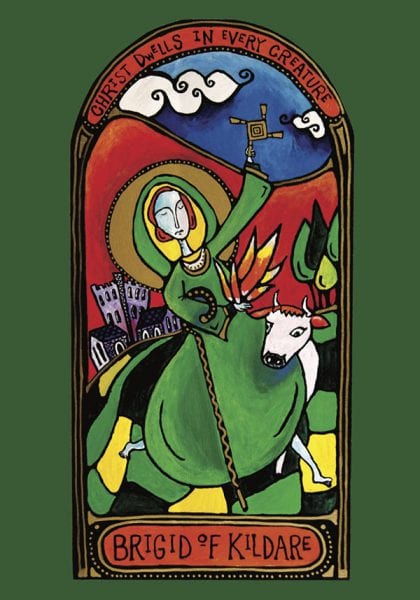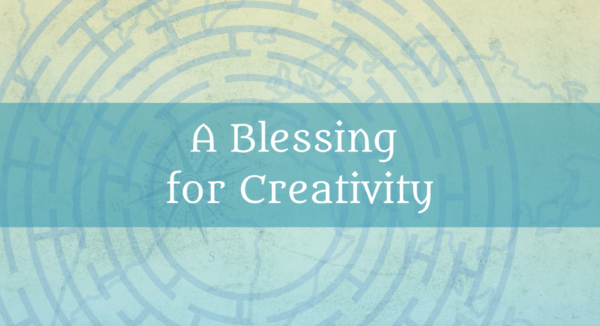 Dearest monks and artists,
Dearest monks and artists,
I am really excited to be offering a brand new online retreat starting tomorrow through the Rowe Center in Massachusetts. The Spiral Way: Celtic Spirituality and the Creative Imagination will be an exploration of Celtic stories and practices which help to cultivate and nourish our creative imaginations. The program will be delivered through four 90-minute live weekly sessions with me and will include meditation, teaching, writing exercises, song, and poetry.
I am especially delighted to begin this journey on the Celtic feast of Imbolc which is also the feast of St. Brigid, one of the wondrous Irish saints known for her hospitality and generosity.
This is an excerpt from our Sacred Seasons online retreat about some of St. Brigid’s gifts for us. Join me on her feast day tomorrow by embarking on the spiral way.
February 1st-2nd marks a confluence of several feasts and occasions including: the Celtic feast of Imbolc, St. Brigid’s Day, Candlemas, Feast of the Presentation, and Groundhog Day!
Imbolc is a Celtic feast that is cross-quarter day, meaning it is the midway point between the winter solstice and spring equinox. The sun marks the four Quarter Days of the year (the Solstices and Equinoxes) and the midpoints are the cross-quarter days. In some cultures February 2nd is the official beginning of spring.
As the days slowly lengthen in the northern hemisphere and the sun makes her way higher in the sky, the ground beneath our feet begins to thaw. The earth softens and the seeds deep below stir in the darkness. The word “imbolc” means “in the belly.” The earth’s belly is beginning to awaken, new life is stirring, seeds are sprouting forth. This mini-retreat draws its invitation from this image.
In many places the ground is still frozen or covered with snow, but the call now is tend to those very first signs of movement beneath the fertile ground. What happens when you listen ever so closely in the stillness? What do you hear beginning to emerge?
St. Brigid
In Ireland, Brigid (c. 451-525) is one of the three main Saints of the land alongside Patrick and Columba. We don’t know many details of her life, and there is great evidence that she is part of a much older lineage extending back to the Irish triple goddess Brigid of pre-Christian times who was the goddess of poets, smithwork, and healing.
Most of what we know about St. Brigid comes from the Life of Brigid written by the monk Cogitosis in the second half of the 7th century. The Life emphasizes her healing, her kinship with animals, her profound sense of hospitality and generosity, and concern for those oppressed. These stories of the Saints are not meant to be literal or historical, but spiritual, mythical, archetypal, and psychological, resonating with the deepest parts of our souls.
Her feast day is February 1st which in the Celtic calendar is also the feast of Imbolc and the very beginning of springtime. It is the time when the ewes begin to give birth and give forth their milk, and heralds the coming of longer and warmer days. She is the first sign of life after the long dark nights of winter. She breathes into the landscape so that it begins to awaken. Snowdrops, the first flowers of spring are one of her symbols.
On the eve of January 31st it is traditional to leave a piece of cloth or ribbon outside the house. It was believed that St Brigid’s spirit traveled across the land and left her curative powers in the brat Bride (Brigid’s Mantle or cloth). It was then used throughout the year as a healing from sickness and protection from harm.
In Ireland Brigid is even called Mary of the Gaels and was said to be present as a midwife to Mary at the birth of Jesus. She crosses thresholds of time and space and these stories often break the boundaries of linearity. It is said that she was born as her mother crossed the threshold of a doorway. Women giving birth often stand on the threshold of a doorway and call out her name.
Brigid was a powerful leader and one of the founders of monasticism in Ireland. She was an abbess, healer, soul friend, prophet, and more. Many miracles are connected to her, especially related to milk. She had a white cow who could give as much milk as needed. A small amount of her butter miraculously feeds many guests. There is a sense of lavish hospitality and generosity connected to the spirit of Brigid. Many of the stories connected to her, reflect the dignity of the ordinary tasks, especially in the home. No more divisions between what is worthy of grace and beyond the scope.
Brigid is especially connected to the elements of water and fire. Many holy wells across Ireland are dedicated to her and wells are places of healing, where those suffering with illness come to be transformed. In Kildare is the perpetual flame of Brigid. When she was consecrated as a nun (and legend says she was inadvertently also ordained bishop) a flame extended from her head up to the heavens. She is invoked for protection in travel, in prayers at night, and in the work of the day. Brigid would also have been immersed in herbal traditions of her time.
Often in Ireland, I have heard Brigid described as a bridge between the pre-Christian and Christian traditions, between the other world and this one. She bridges the natural and human world. Brigid sees the face of Christ in all persons and creatures, and overcomes the division between rich and poor. Our practice of inner hospitality as monks in the world is essentially about healing all of places we feel fragmented, scattered, and shamed. One of her symbols is her cloak which becomes a symbol of unity. All can dwell under her mantle.
I have come to embrace and love Brigid more and more the longer I live in this sacred landscape. From visiting her holy wells, to participating in the festivals for her feast day which continue to celebrate her gifts for the world, to her kinship with creatures, I discover in Brigid a powerful source of wisdom for how to be with the places within me which often feel divided. I find myself calling on her name in times of illness or other places where the gap between my heart’s longing and how I am living feels too very large.
With great and growing love,
Christine
Image credit: © Marcy Hall at Rabbit Room Arts


